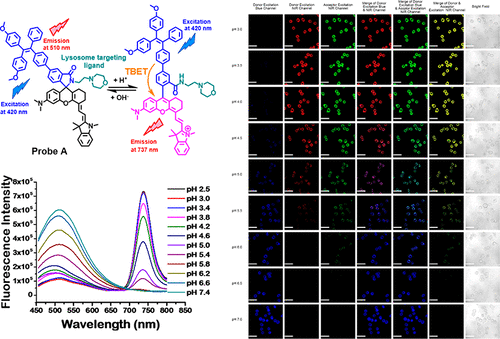当前位置:
X-MOL 学术
›
Bioconjugate Chem.
›
论文详情
Our official English website, www.x-mol.net, welcomes your
feedback! (Note: you will need to create a separate account there.)
Ratiometric Near-Infrared Fluorescent Probes Based On Through-Bond Energy Transfer and π-Conjugation Modulation between Tetraphenylethene and Hemicyanine Moieties for Sensitive Detection of pH Changes in Live Cells
Bioconjugate Chemistry ( IF 4.0 ) Pub Date : 2018-03-01 00:00:00 , DOI: 10.1021/acs.bioconjchem.8b00111 Jianbo Wang,Shuai Xia,Jianheng Bi,Mingxi Fang,Wafa Mazi,Yibin Zhang,Nathan Conner,Fen-Tair Luo,H. Peter Lu,Haiying Liu
Bioconjugate Chemistry ( IF 4.0 ) Pub Date : 2018-03-01 00:00:00 , DOI: 10.1021/acs.bioconjchem.8b00111 Jianbo Wang,Shuai Xia,Jianheng Bi,Mingxi Fang,Wafa Mazi,Yibin Zhang,Nathan Conner,Fen-Tair Luo,H. Peter Lu,Haiying Liu

|
In this paper, we present three ratiometric near-infrared fluorescent probes (A–C) for accurate, ratiometric detection of intracellular pH changes in live cells. Probe A consists of a tetraphenylethene (TPE) donor and near-infrared hemicyanine acceptor in a through-bond energy transfer (TBET) strategy, while probes B and C are composed of TPE and hemicyanine moieties through single and double sp2 carbon–carbon bond connections in a π-conjugation modulation strategy. The specific targeting of the probes to lysosomes in live cells was achieved by introducing morpholine residues to the hemicyanine moieties to form closed spirolactam ring structures. Probe A shows aggregation-induced emission (AIE) property at neutral or basic pH, while probes B and C lack AIE properties. At basic or neutral pH, the probes only show fluorescence of TPE moieties with closed spirolactam forms of hemicyanine moieties, and effectively avoid blind fluorescence imaging spots, an issue which typical intensity-based pH fluorescent probes encounter. Three probes show ratiometric fluorescence responses to pH changes from 7.0 to 3.0 with TPE fluorescence decreases and hemicyanine fluorescence increases, because acidic pH makes the spirolactam rings open to enhance π-conjugation of hemicyanine moieties. However, probe A shows much more sensitive ratiometric fluorescence responses to pH changes from 7.0 to 3.0 with remarkable ratio increase of TPE fluorescence to hemicyanine fluorescence up to 238-fold than probes B and C because of its high efficiency of energy transfer from TPE donor to the hemicyanine acceptor in the TBET strategy. The probe offers dual Stokes shifts with a large pseudo-Stokes shift of 361 nm and well-defined dual emissions, and allows for colocalization of the imaging readouts of visible and near-infrared fluorescence channels to achieve more precisely double-checked ratiometric fluorescence imaging. These platforms could be employed to develop a variety of novel ratiometric fluorescent probes for accurate detection of different analytes in applications of chemical and biological sensing, imaging, and diagnostics by introducing appropriate sensing ligands to hemicyanine moieties to form on–off spirolactam switches.
中文翻译:

基于四苯乙烯和半花青部分之间的键合能量转移和 π 共轭调制的比例近红外荧光探针,用于灵敏检测活细胞中的 pH 变化
在本文中,我们提出了三种比率式近红外荧光探针 ( A – C ),用于准确、比率式检测活细胞内的 pH 变化。探针A由四苯乙烯(TPE)供体和近红外半花青受体通过键合能量转移(TBET)策略组成,而探针B和C则由TPE和半花青部分通过单sp 2碳-碳键和双sp 2碳-碳键组成π-共轭调制策略中的连接。通过将吗啉残基引入半花青部分以形成闭合的螺内酰胺环结构,实现了探针对活细胞中溶酶体的特异性靶向。探针A在中性或碱性 pH 值下显示聚集诱导发射 (AIE) 特性,而探针B和C缺乏 AIE 特性。在碱性或中性pH下,探针仅显示具有封闭螺内酰胺形式的半花青部分的TPE部分的荧光,有效避免了典型的基于强度的pH荧光探针遇到的荧光成像盲点问题。三种探针显示出对 pH 从 7.0 到 3.0 变化的比率荧光响应,其中 TPE 荧光减少,半花青荧光增加,因为酸性 pH 使螺内酰胺环打开,增强半花青部分的 π 共轭。然而,探针A对 pH 从 7.0 到 3.0 的变化表现出更灵敏的比率荧光响应,TPE 荧光与半花青荧光的比率显着增加,比探针B和C高达 238 倍,因为它从 TPE 供体到半花青荧光的能量转移效率很高。 TBET 策略中的半花青受体。 该探头提供双斯托克斯位移,具有 361 nm 的大伪斯托克斯位移和明确的双发射,并允许可见光和近红外荧光通道的成像读数共定位,以实现更精确的双重检查比率荧光成像。这些平台可用于开发各种新型比率荧光探针,通过将适当的传感配体引入半花青部分形成开关螺内酰胺开关,准确检测化学和生物传感、成像和诊断应用中的不同分析物。
更新日期:2018-03-01
中文翻译:

基于四苯乙烯和半花青部分之间的键合能量转移和 π 共轭调制的比例近红外荧光探针,用于灵敏检测活细胞中的 pH 变化
在本文中,我们提出了三种比率式近红外荧光探针 ( A – C ),用于准确、比率式检测活细胞内的 pH 变化。探针A由四苯乙烯(TPE)供体和近红外半花青受体通过键合能量转移(TBET)策略组成,而探针B和C则由TPE和半花青部分通过单sp 2碳-碳键和双sp 2碳-碳键组成π-共轭调制策略中的连接。通过将吗啉残基引入半花青部分以形成闭合的螺内酰胺环结构,实现了探针对活细胞中溶酶体的特异性靶向。探针A在中性或碱性 pH 值下显示聚集诱导发射 (AIE) 特性,而探针B和C缺乏 AIE 特性。在碱性或中性pH下,探针仅显示具有封闭螺内酰胺形式的半花青部分的TPE部分的荧光,有效避免了典型的基于强度的pH荧光探针遇到的荧光成像盲点问题。三种探针显示出对 pH 从 7.0 到 3.0 变化的比率荧光响应,其中 TPE 荧光减少,半花青荧光增加,因为酸性 pH 使螺内酰胺环打开,增强半花青部分的 π 共轭。然而,探针A对 pH 从 7.0 到 3.0 的变化表现出更灵敏的比率荧光响应,TPE 荧光与半花青荧光的比率显着增加,比探针B和C高达 238 倍,因为它从 TPE 供体到半花青荧光的能量转移效率很高。 TBET 策略中的半花青受体。 该探头提供双斯托克斯位移,具有 361 nm 的大伪斯托克斯位移和明确的双发射,并允许可见光和近红外荧光通道的成像读数共定位,以实现更精确的双重检查比率荧光成像。这些平台可用于开发各种新型比率荧光探针,通过将适当的传感配体引入半花青部分形成开关螺内酰胺开关,准确检测化学和生物传感、成像和诊断应用中的不同分析物。











































 京公网安备 11010802027423号
京公网安备 11010802027423号